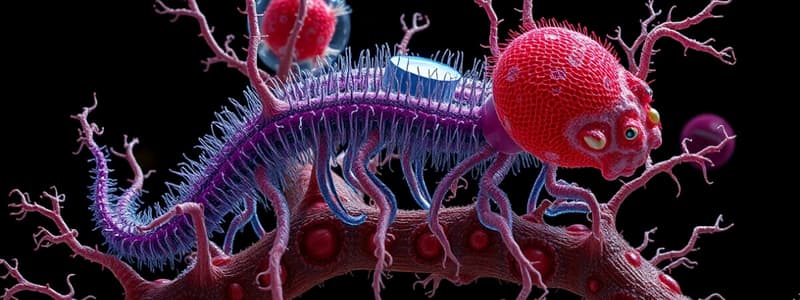Podcast
Questions and Answers
What process primarily leads to the development of adaptations in animals?
What process primarily leads to the development of adaptations in animals?
- Natural selection (correct)
- Mutations
- Genetic drift
- Gene flow
Which of the following is NOT considered a crucial role of animals in ecosystems?
Which of the following is NOT considered a crucial role of animals in ecosystems?
- Acting solely as food sources (correct)
- Maintaining biodiversity
- Participating in nutrient cycling
- Being essential to predator-prey relationships
What is considered a major milestone in the evolutionary history of animals?
What is considered a major milestone in the evolutionary history of animals?
- Development of single-celled organisms
- Evasion from natural disasters
- Evolution of specialized tissues and organ systems (correct)
- Decreased competition among species
Which statement accurately reflects the significance of studying animals in biology?
Which statement accurately reflects the significance of studying animals in biology?
Which of the following adaptations is a method used by animals to improve their survival?
Which of the following adaptations is a method used by animals to improve their survival?
What characteristic is unique to animals compared to plants?
What characteristic is unique to animals compared to plants?
Which phylum is known for having radial symmetry and stinging cells?
Which phylum is known for having radial symmetry and stinging cells?
Which of the following statements about animal development is true?
Which of the following statements about animal development is true?
What type of nutrition do animals primarily exhibit?
What type of nutrition do animals primarily exhibit?
Which of the following phyla is characterized by being mostly parasitic with bilateral symmetry?
Which of the following phyla is characterized by being mostly parasitic with bilateral symmetry?
In the context of animal diversity, what does adaptation refer to?
In the context of animal diversity, what does adaptation refer to?
Which animal phylum is known for its segmented body plan?
Which animal phylum is known for its segmented body plan?
Which characteristic is NOT commonly associated with animals?
Which characteristic is NOT commonly associated with animals?
Flashcards
Multicellular
Multicellular
Living things made of many cells, with organized tissues, organs, and organ systems.
Heterotrophic
Heterotrophic
Cannot make their own food, they obtain energy by consuming other organisms.
Eukaryotic
Eukaryotic
Have a nucleus and other membrane-bound organelles in their cells.
Lack of cell walls
Lack of cell walls
Signup and view all the flashcards
Specialized Tissues and Organs
Specialized Tissues and Organs
Signup and view all the flashcards
Motile
Motile
Signup and view all the flashcards
Sexual Reproduction
Sexual Reproduction
Signup and view all the flashcards
Development
Development
Signup and view all the flashcards
Adaptations
Adaptations
Signup and view all the flashcards
Natural Selection
Natural Selection
Signup and view all the flashcards
Biodiversity
Biodiversity
Signup and view all the flashcards
Nutrient Cycling
Nutrient Cycling
Signup and view all the flashcards
Animal Models in Research
Animal Models in Research
Signup and view all the flashcards
Study Notes
Kingdom Animalia: Overview
- Animals are multicellular, eukaryotic organisms.
- They are heterotrophic, obtaining energy by consuming other organisms.
- They are typically motile (able to move), though some are sessile.
- Their cells lack cell walls.
- Animals reproduce sexually, although some can reproduce asexually.
- They exhibit a wide range of body plans, sizes, and complexities.
- Animals are categorized into various phyla based on shared characteristics.
Key Characteristics of Animals
- Multicellularity: Composed of multiple cells organized into tissues, organs, and organ systems.
- Heterotrophic Nutrition: Cannot produce their own food; obtain energy by consuming other organisms.
- Eukaryotic Cells: Possess a nucleus and other membrane-bound organelles.
- Lack of Cell Walls: Animal cells lack rigid cell walls, unlike plant cells.
- Specialized Tissues and Organs: Animals have a wide array of specialized tissues and organs for specific functions.
- Most are Motile: Most animals move independently, but some are sessile.
- Sexual Reproduction: Most animals reproduce sexually, with sperm and egg fusion forming a zygote.
- Development: Animal embryos undergo specific developmental stages.
Animal Phyla (Examples)
- Porifera (Sponges): Simple animals with porous bodies; lack true tissues and organs.
- Cnidaria (Jellyfish, Corals): Radially symmetrical animals with stinging cells (nematocysts).
- Platyhelminthes (Flatworms): Bilateral symmetry, unsegmented body plan; often parasitic.
- Nematoda (Roundworms): Bilateral symmetry, unsegmented body plan; often microscopic.
- Annelida (Segmented Worms): Bilateral symmetry, segmented body plan.
- Mollusca (Snails, Clams, Squids): Bilateral symmetry, soft bodies often with a shell.
- Arthropoda (Insects, Crustaceans, Spiders): Bilateral symmetry, segmented bodies, exoskeletons, jointed appendages.
- Echinodermata (Sea Stars, Sea Urchins): Radially symmetrical as adults, deuterostomes.
- Chordata (Vertebrates and invertebrates like lancelets): Notochord, dorsal hollow nerve cord, pharyngeal slits, post-anal tail (at some stage).
Diversity and Adaptations
- Animals display immense biodiversity, adapted to diverse habitats and ecological niches.
- Adaptations are structures/behaviors increasing survival and reproduction in specific environments.
- Adaptations include camouflage, mimicry, feeding mechanisms, and sensory organs.
- Adaptations evolve through natural selection.
Importance of Animals
- Animals play crucial roles in ecosystems as prey and predators.
- They maintain biodiversity and nutrient cycling.
- Many animals are essential food and resource sources for humans.
- Some animals hold cultural or religious significance.
Evolutionary History
- Animals evolved from a single-celled eukaryotic ancestor.
- Evolution of complex body plans, organ systems, and tissues is significant in animal evolution.
- The fossil record supports this evolutionary history.
Significance in Biology
- Studying animals is vital for understanding biological processes (development, physiology, behavior).
- Animal models are valuable tools for biomedical research.
- Studying animal ecosystems is crucial for conservation efforts.
Studying That Suits You
Use AI to generate personalized quizzes and flashcards to suit your learning preferences.





